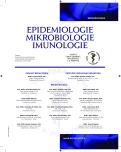Treponema pallidum subspecies pallidum – the Causative Agent of Neurosyphilis
Authors:
Salavec Miloslav 1; Boštíková Vanda 2; Vaňásková Zuzana 3; Smetana Jan 2; Sleha Radek 2; Coufalová Monika 2; Plíšek Stanislav 4; Špliňo Miroslav 2; Štěpánová Vlasta 5; Boštík Pavel
Authors‘ workplace:
Klinika nemocí kožních a pohlavních, FN a LF UK, Hradec Králové
1; Katedra epidemiologie, FVZ UO, Hradec Králové
2; Odborná neurologická ordinace, Hradec Králové
3; Klinika infekčních nemocí, FN a LF UK, Hradec Králové
4; Ústav klinické mikrobiologie, FN a LF UK Hradec Králové
5; Centrum pokročilých studií, FVZ UO, Hradec Králové
6
Published in:
Epidemiol. Mikrobiol. Imunol. 62, 2013, č. 3, s. 91-99
Overview
Neurosyphilis is defined as infection of central nervous system by Treponema pallidum subspecies pallidum. Neurosyphilis can develop at any stage after initial infection and is reflected in laboratory results. The pathogenesis of neurosyphilis is similar to that of classical form of syphilis. Individuals with persistent abnormalities in the cerebrospinal fluid are at risk of the development of clinical manifestations. Proper understanding of particular forms of neurosyphilis for differential diagnosis is important to determine potential risk of the development of progressive disease in neurology.
Keywords:
neurosyphilis – Treponema pallidum – meningitis – meningovascular disease – differential diagnosis
Sources
1. Golden, M. R., Marra, C. M., Holmes, K. K. Update on syphilis: resurgence of an old problem. JAMA, 2003, 11, p. 1510–1514.
2. Timmerman, M., Carr, J. Neurosyphilis in the modern era. Neurol. Neurosurg. Psychiatry, 2004, 12, p. 1727–1730.
3. Marra, C. M. Syphilis and human immunodeficiency virus infection. Semin. Neurol., 1992, 1, p. 43–50.
4. Symptomatic early neurosyphilis among HIV-positive men who have sex with men – four cities. United States, January 2002-June 2004. MMWR Morb Mortal Wkly Rep., 2007, 25, p. 625–628.
5. Knudsen, R. P. Neurosyphilis Overview of Syphilis of the CNS. Dostupné na www: http://emedicine.medscape.com/article//1169231-overview#aw2aab6b5.
6. Štork, J. Dermatovenerologie. Galén, ISBN 978-80-7262-371-6, 2008.
7. Holmes, M. D., Brant-Zawadzki, M. M., Simon, R. P. Clinical features of meningovascular syphilis. Neurology, 1984, 4, p. 553–556.
8. Lanska, D. J. The suspension apparatus for tabes dorsalis. Neurology, 1999, 52, 6, p. 1295.
9. Duffy, J. D. General paralysis of the insane: neuropsychiatry’s first challenge. J. Neuropsychiatry Clin. Neurosci. Spring., 1995, 2, p. 243–249.
10. Doris, J. P., Saha, K., Jones, N. P., Sukthankar, A. Ocular syphilis: the new epidemic. Eye, Jun 2006; 6, p. 703–705.
11. Prokosch, V., Thanos, S., Busse, H., Stupp, T. Ophthalmological symptoms as key findings in neurosyphilis – diagnosis and therapy. Klin. Monatsbl. Augenheilkd., 2009, 3, p. 184–188.
12. Lair, L., Naidech, A. M. Modern neuropsychiatric presentation of neurosyphilis. Neurology, 2004, 7, p. 1331–1333.
13. Rundell, J. R., Wise, M. G. Neurosyphilis: a psychiatric perspective. Psychosomatics, 1985, 4, s. 287–290.
14. Augenbraun, M. H. Treatment of syphilis 2001: nonpregnant adults. Clin. Infect. Dis., 2002, 35, p. 187–90.
15. Brown, D. L., Frank, J. E. Diagnosis and management of syphilis. Am. Fam. Physician., 2003, 2, p. 283–290.
16. Scheck, D. N., Hook, E. W. Neurosyphilis. Infect. Dis. Clin. North. Am., 1994, 4, p. 769–95.
17. Young, H. Syphilis: new diagnostic directions. Int. J. STD AIDS, 1992, 6, p. 391–413.
18. Workowski, K. A., Berman, S. M. Centers for Disease Control and Prevention. Sexually transmitted diseases treatment guidelines. 2006, MMWR Recomm Rep., 2006, 55(RR-11), p. 1–94.
19. Lukehart, S. A., Hook, E. W., Baker-Zander, S. A., Collier, A. C., Critchlow, C. W., Handsfield, H. H. Invasion of the central nervous system by Treponema pallidum: implications for diagnosis and treatment. Ann. Intern. Med., 1988, 11, p. 855–862.
20. French, P., Gomberg, M., Janier, M., Schmidt, B., van Voorst Vader. P., Young, H. 2008 European Guidelines on the Management of Syphilis. Int. J. STD AIDS, 2009, 5, p. 300–309.
21. United States Preventive Services Task Force. Screening for syphilis infection: recommendation statement. 2004.
22. Gaudio, P. A. Update on ocular syphilis. Curr. Opin. Ophtalmol., 2006, 17, p. 562.
23. Yimtae, K., Sriromptong, S., Lertsukprasert, K. Otosyphilis: a review of 85 cases. Otolaryngol. Head Neck Surg., 2007, 136, p. 67.
24. Marra, C. M., Gonzales-Scarano, F., Bartlett, J. G., Dashe, J. F. UpToDate Neurosyphilis. Dostupné na www: http://neurores.wikidot.com/utd-neurosyphillis.
25. Národní referenční laboratoř pro diagnostiku syfilis. Státní zdravotní ústav, Praha. Dostupné na www: http://www.szu.cz/narodni-referencni-laborator-diagnostiku-syfilis.
26. Zákoucká, H. Sérologická diagnostika syfilis. Dostupné na www: http://www.ceva-edu.cz/mod/forum/discuss.php?d=573.
27. Štork, J. et al. Dermatovenrologie. Galen 2008, ISBN 978-80-7262-371-6, s. 442
Labels
Hygiene and epidemiology Medical virology Clinical microbiologyArticle was published in
Epidemiology, Microbiology, Immunology

2013 Issue 3
Most read in this issue
- Diagnosis of Whooping Cough by Serology and Real-Time PCR
- Prevalence of selected congenital anomalies in the Czech Republic: renal and cardiac anomalies and congenital chromosomal aberrations
- Treponema pallidum subspecies pallidum – the Causative Agent of Neurosyphilis
- Dengue Fever Cases in Czech Workers Returning from the Maldives
